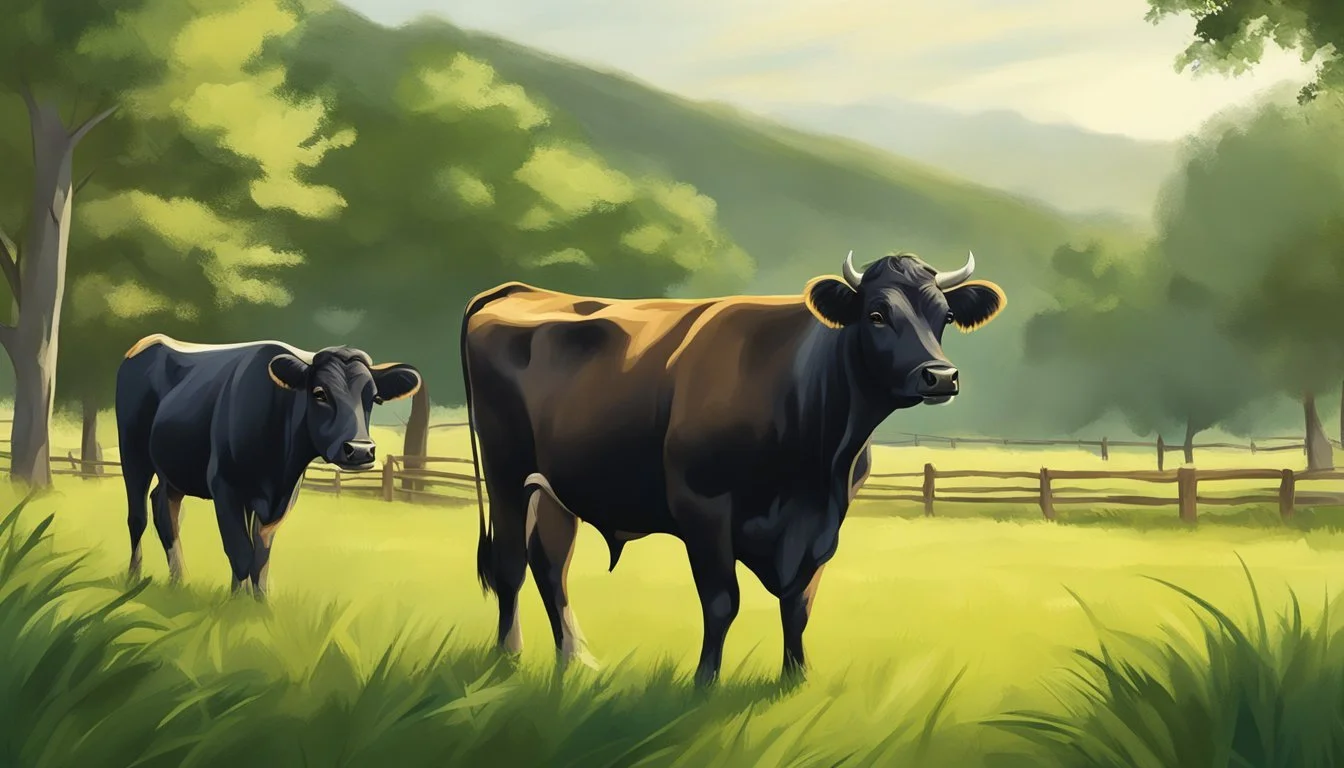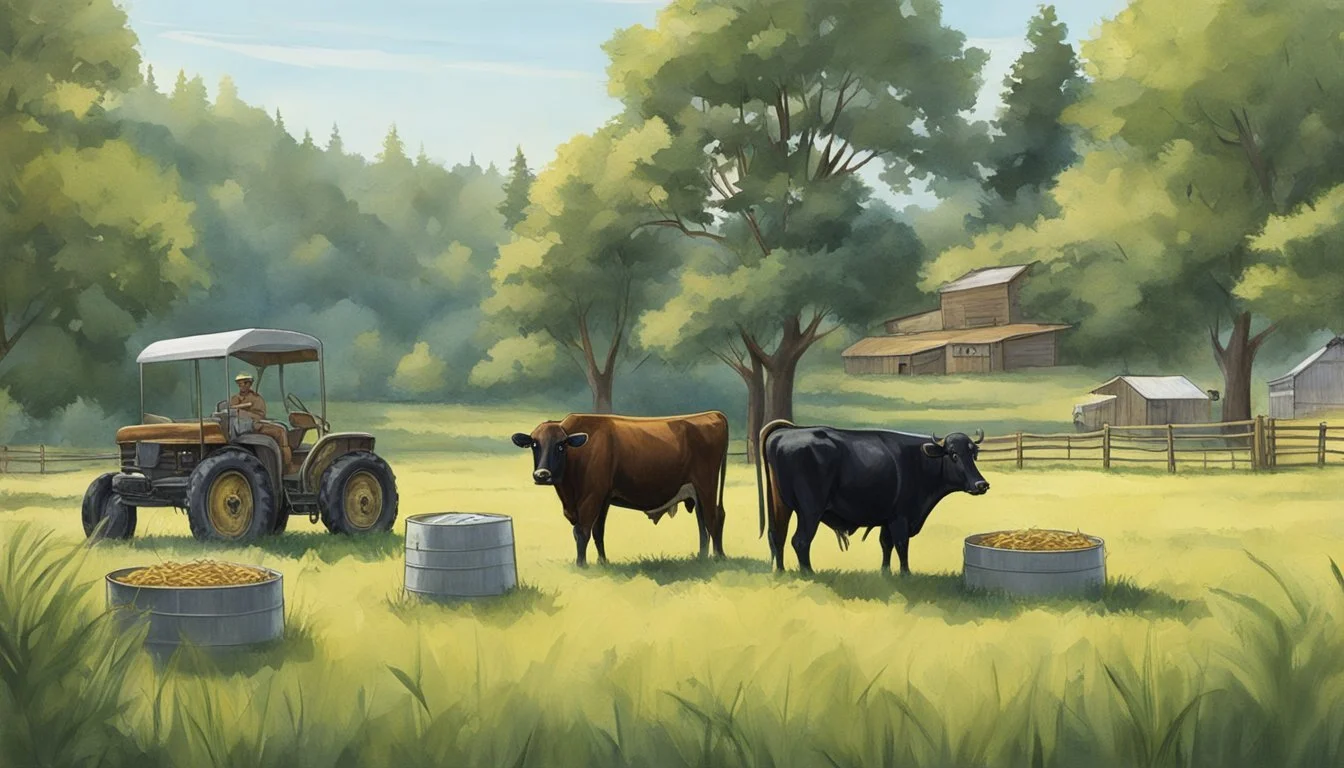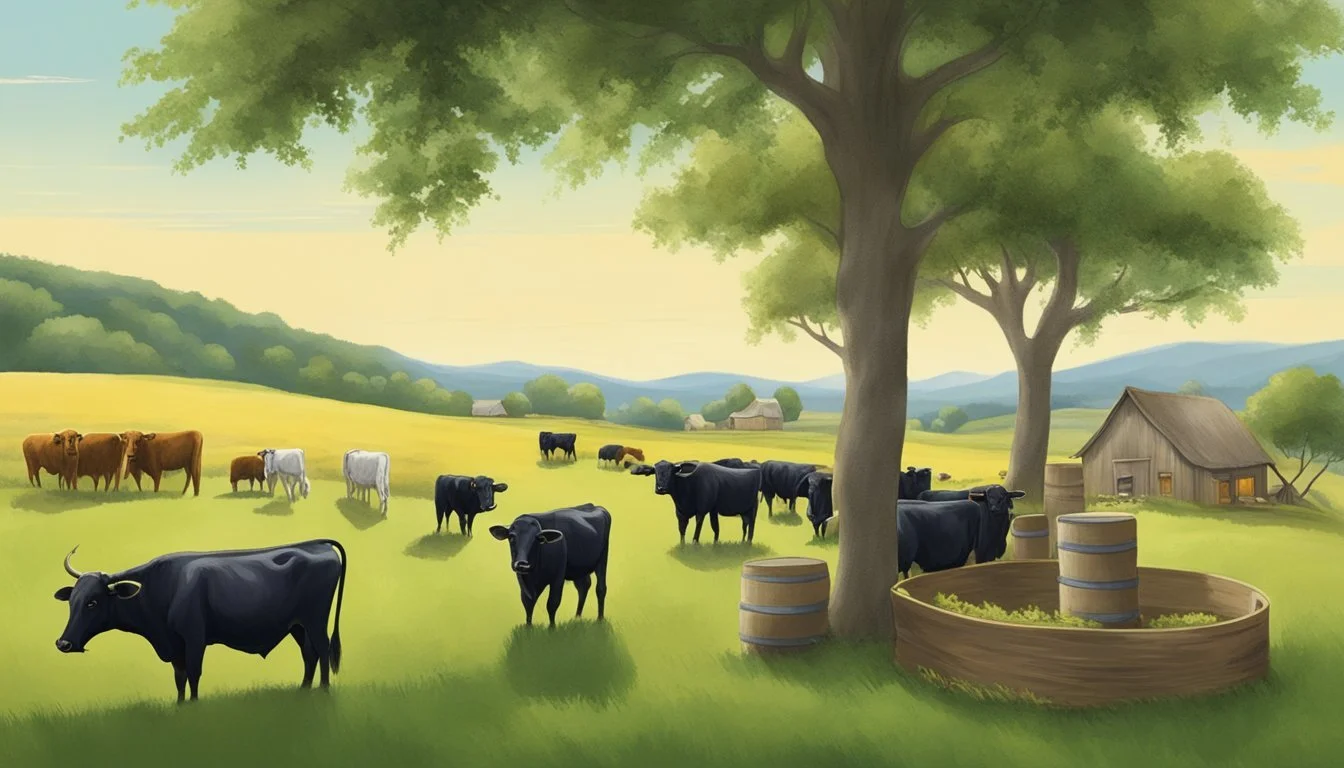Dexter Cattle and the Small-Scale Cheese Maker
Exploring the Symbiotic Relationship
Dexter cattle, a compact and hardy breed, have emerged as a suitable option for small-scale farmers interested in both meat and dairy production. With their smaller size and efficient feed-to-milk conversion, these cattle are uniquely advantageous for artisanal cheesemakers looking to produce high-quality dairy on a modest scale. Dexter cows have the capability to produce rich, creamy milk, which is an excellent base for crafting a variety of cheeses (What wine goes well with cheese?), including the niche market favorite, kefir cheese. Because of their manageable size, these cattle are a sensible choice for operations with limited space, needing as little as half an acre per animal.
Small-scale cheesemaking has been on the rise as consumers increasingly seek out locally sourced and handcrafted foods with distinct flavors and sustainable roots. The combination of Dexter cattle and small-scale cheese production capitalizes on this trend, offering opportunities for farmers to diversify their products and cater to a niche market. The use of Dexters in cheesemaking not only supports the preservation of this heritage breed but also provides a high-quality, specialty product that stands out in the marketplace.
The relationship between Dexter cattle and small-scale cheesemakers demonstrates a symbiotic existence, highlighting an opportunity for sustainable farming. Producers can use Dexter cattle to efficiently transform a modest volume of milk into high-value cheese varieties, enhancing farm resilience and consumer appeal. As such, Dexter cattle and small-scale cheesemakers form a perfect pair, epitomizing how thoughtful agricultural practices and artisanal food production can go hand-in-hand, benefitting both the farmer and the end consumer.
The Dexter Breed: History and Characteristics
The Dexter breed has a rich history and distinct characteristics that make it ideal for small-scale farming, including cheese production.
Origins and Development
Dexter cattle are native to Ireland, with their origins dating back to the 18th century in County Kerry. They are believed to be named after a Mr. Dexter, who worked for Lord Hawarden on Valentia Island. As a robust and versatile breed, dexter cattle were officially distinguished from the Kerry breed in the late 19th century. The English Kerry and Dexter Cattle Society, founded in 1892 initially supported both Kerry and Dexter cattle but later shifted its focus exclusively to Dexters. The herd book from 1926 records significant numbers, with 986 bulls and 3,896 cows registered by that time, indicating their early popularity among breeders.
Physical Description and Varieties
Dexter cattle are small, hardy animals with adults standing 36 to 44 inches tall at the shoulder and weighing up to 750 pounds. They exhibit three primary coat colors:
Dun
Black
Red
The breed is characterized by their horns, which are short and moderately thick, but polled (naturally hornless) Dexters are also found. Their small size should not be underestimated, as it contributes to their hardiness and adaptability, making them well-suited to a variety of climates and grazing conditions. Dexter cattle are valued for their dual-purpose nature, with the females being efficient milk producers and the meat being of high quality. Their milk is particularly noted for its high butterfat content, excellent for cheese making.
Dexter Cattle in Dairy Production
Dexter cattle are valued in the dairy sector for producing rich milk with high butterfat, ideal for cheese making. They adapt well to various dairy management systems and can be milked using conventional equipment.
Milk Quality and Cheese Making Potential
Dexter cattle contribute a rich milk with a higher butterfat content, typically around 4%, which is beneficial for cheese production. The cream extracted from this milk can be used to produce artisanal cheeses, such as kefir cheese. Their milk's quality and richness make it particularly suitable for small-scale cheese makers looking to create premium dairy products.
Milking Procedures and Equipment
Milking Dexter cattle requires standard milking procedures that are in line with other dairy breeds. The compact size of the Dexter cow is advantageous, as it can be milked using a standard milking machine without modifications. The equipment should be kept clean and sanitized to maintain milk quality.
Milking Frequency: Depending on the desired milk production levels, Dexter cattle are usually milked one to two times per day.
Equipment Maintenance: Regular checks on milking machines ensure effective and clean milking procedures.
Dairy Management and Maintenance
Effective dairy management is crucial for maintaining milk production and health of Dexter cattle. They are robust and can thrive on a pasture-based diet, which is supplemented with grain to fulfill their nutritional needs. Regular veterinary care and adherence to a scheduled maintenance program help prevent diseases and maintain continuous milk production.
Feeding: A balanced diet is essential to sustain high-quality milk yield.
Health Checks: Routine health monitoring and vaccinations safeguard against common bovine diseases.
Dexter cattle are fit for both established dairies and those starting with small-scale cheese production, providing them with a versatile and productive breed for diversifying their dairy offerings.
Benefits of Dexter Cattle for Small Farms
Dexter cattle offer a unique combination of traits making them particularly well-suited for small-scale farming, providing economic advantages while supporting sustainable agriculture through their hardiness and adaptability.
Economic Advantages
Cost Efficiency: Dexter cattle require less feed compared to larger breeds, translating to lower food costs. On a small farm, this characteristic is a substantial financial benefit.
High Yield: Despite their smaller size, Dexters have a higher meat conversion rate, meaning they produce more meat per pound of feed than many dairy breeds.
Adaptability and Hardiness
Climate Resilience: These cattle are known to thrive in a variety of climates, from wet and cold to dry and hot, reducing the need for specialized housing.
Grazing Flexibility: They are efficient grazers, which can lead to reduced dependency on supplemental feeding, particularly on small farms where pasture space may be abundant but limited.
Sustainable Agriculture and Environmental Impact
Reduced Land Use: Dexter cattle, requiring less space than larger breeds, are a choice that aligns with sustainability as they ease the pressure on land resources.
Environmental Footprint: The breed’s ability to thrive on pasture helps promote a healthier ecosystem through the natural cycling of nutrients, leading to improved soil health and less reliance on chemical fertilizers.
Feeding and Care for Optimal Health
Ensuring the health and productivity of Dexter cattle, especially for cheese-making operations, hinges on a well-managed feeding program and diligent care practices. Understanding the specific nutritional needs and maintaining high-quality pasture and forage are foundational to their well-being.
Nutritional Needs
Dexter cattle require a balanced diet to produce quality milk for cheese making. Their diet should consist of:
Grass and Hay: Foundations of Dexter nutrition, providing the majority of required nutrients.
Grain: A supplemental source of energy, especially beneficial during lactation or for finishing beef.
Water: Clean, fresh water must be available at all times to support health and milk production.
Minerals and Vitamins: Essential for immune function and overall health, often provided through licks or supplements.
Pasture Management and Forage
A robust pasture management strategy enhances the quality of forage, which directly impacts cattle health and milk quality.
Rotational Grazing: Implementing a rotational system to allow for regrowth supports sustainable forage supply.
Soil Fertility: Regular soil testing and appropriate fertilization ensure the forage is nutrient-rich.
Forage Variety: A mix of grasses caters to the complete nutritional needs of Dexter cattle.
Weed Control: Maintaining pastures free of noxious weeds protects the health of the cattle and the quality of the forage they consume.
The Dual-Purpose Advantage
Dexter cattle embody the concept of versatility as dual-purpose animals, providing quality beef and functioning as working animals.
Meat Production
Dexter cattle excel in meat production due to their impressive meat conversion rate. A Dexter cow can yield more than 60% meat, relative to its body size, offering a substantial quantity of lean, quality beef. They potentially provide up to 400 pounds of meat, a significant amount considering their compact size. Dexter beef is known for its rich flavor profile, reflecting their grass-fed diet.
The Role of Dexter Cows as Working Animals
Not only are Dexter cows valued for their meat, but they also serve as working animals. Their strength and docile nature make them suitable for farm work, such as pulling plows or wagons. Utilized as oxen, these cattle contribute to the operations of the farm beyond meat and milk production, truly demonstrating their dual-purpose nature.
Breeding and Lifecycle
In the lifecycle of Dexter cattle, deliberate breeding practices and meticulous attention to calving and growth stages are critical for maintaining a healthy and sustainable herd.
Breeding Practices
Dexter cattle breeders often employ a 365-day breeding cycle, which includes a gestation period of approximately 283 days. Bulls may demonstrate a longer gestation for bull calves, typically 1-7 days longer compared to heifer calves. Given this timeframe, it’s commonplace for farmers to anticipate the arrival of a new calf within a 10-day window around the due date. Effective breeding practices involve:
Recording the breeding dates to accurately predict calving and manage herd genetics.
Ensuring genetic diversity within the breeding pool to promote a robust and healthy family cow lineage.
Selecting for specific traits that enhance the characteristics of a dual-purpose breed, serving both dairy and meat production.
Calving and Growth
After the gestation period, calving should occur with careful oversight to ensure the health of both cow and calf. Key points to consider:
Monitoring for the signs of labor to provide necessary assistance if required.
The first few hours after birth are vital, with the calf needing to ingest colostrum for essential antibodies.
Weaning typically takes place between 6 to 8 months, allowing for solid food transition.
Lifespan for Dexter cattle can reach up to 20 years, while they reach maturity at around 18 months to 2 years.
Calves grow relatively quickly, reflecting the breed's hardiness and adaptability.
Keeping a detailed growth chart can assist breeders in making informed decisions for the herd's future, and ensuring individual animals meet the necessary benchmarks for a successful small-scale cheese-making venture.
Size and Management Considerations
When considering Dexter cattle for small-scale cheese making, their size and temperament play a crucial role in their management and the space required for their housing and care.
Housing and Shelter Requirements
Dexter cattle, with their small size, require less space than larger breeds. An adult Dexter typically weighs less than 340 kg (750 lbs), which translates into less land and smaller shelter needs. They need a dry, well-ventilated space to protect them from harsh weather conditions. Shelter dimensions should accommodate their stature, with a recommended height of at least 1.5 meters (5 feet) to provide adequate clearance. A standard setup may include:
A covered area for resting and feeding
Access to an outdoor paddock for grazing
Sufficient space to reduce crowding and stress
Handling and Temperament
Dexters are known for being docile and easy to handle which is beneficial for cheese makers who may have limited assistance. Their management is straightforward because they have a calm disposition, making routine tasks like milking, veterinary check-ups, and daily care less strenuous. It is important to handle them regularly to maintain this temperament. Key points include:
Regular human interaction to maintain their docile nature
Gentle handling techniques to ensure stress-free care
Training for routine care can be accomplished with minimal equipment such as lead ropes and halters
Marketing and Community Building
In the realm of small-scale dairies, the marketing of Dexter cattle products and the crafting of artisanal kefir cheese intersect to form a unique niche market. Strategic partnerships and community engagement are critical for success in these endeavors.
Connecting with Cheese Makers and Consumers
For small-scale dairy farms specializing in Dexter cattle, establishing a connection with cheese makers is essential. The American Dexter Cattle Association offers a platform for networking that farmers can leverage to market their rich-flavored, grain-fed Dexter products. It is essential to highlight the unique qualities of Dexter milk, often used for its rich flavor and high butterfat content, which is ideal for creating premium kefir cheese. Direct marketing strategies, such as community-supported agriculture (CSA) shares or farm-to-table events, can be effective in building a loyal consumer base. Local farmers' markets also offer a venue to showcase products, educating consumers about the benefits of raw milk and the superior taste of Dexter breed cheeses.
Consumer Engagement Strategies:
CSA shares: Offer consumers a share of the production, fostering a sense of community and loyalty.
Farm-to-table events: Host dining experiences that feature products and educate attendees.
Farmers' markets: Use this space to meet consumers face-to-face and offer cheese tastings.
Educational Outreach and Resources
Providing educational resources is a powerful tool for community building within the Dexter cattle and small-scale cheese-making industry. A Sare Grant can be instrumental in developing outreach programs and educational materials. These resources help in informing consumers about the benefits of supporting small-scale dairies and the distinctive qualities of Dexter cattle products. Education extends to proper handling and processing of raw milk to ensure safety and maintain quality for cheese-making processes. Sharing knowledge through workshops, farm tours, or online content can amplify the visibility of the farm and its products, strengthening the community and promoting sustainable practices.
Educational Tools:
Workshops and farm tours: Showcase the process from milk to cheese and the care of Dexter cattle.
Online content: Use social media or a farm website to share information about small-scale dairy benefits and practices.
Comparative Analysis with Other Breeds
In the context of small-scale cheese making, Dexter cattle offer distinct advantages when compared to conventional cattle breeds. Their compact size and high butterfat milk production position them as ideal for small farming operations. This section examines the key differences between Dexter cattle and two other prominent breeds: Holstein and Lowline Angus.
Dexter vs. Holstein
Holstein:
Milk Yields: Exceptional, with averages of 23,000 pounds per lactation.
Butterfat Content: Typically ranges around 3.5%, less suited for cheese production.
Size: Large, cows weigh between 1,500 and 1,800 pounds.
Breeders' preference: Often favored for industrial-scale dairy due to high milk volume.
Dexter:
Milk Yields: More modest, producing about 1.5-2.5 gallons per day.
Butterfat Content: Higher, generally 4%-5%, excellent for cheese and butter.
Size: Smaller stature, cows weigh between 750 to 900 pounds.
Breeders' preference: Attracts those managing small-scale dairy operations focused on high-quality products.
Differences:
Dexter cattle are more manageable due to their lower body weight, making them more suitable for smaller pastures and barns.
High butterfat percentage in Dexter milk is advantageous for cheese-making compared to the lower butterfat content of Holstein milk.
Dexter vs. Lowline Angus
Lowline Angus:
Size: Compact, similar to Dexter, but primarily raised for beef.
High-Quality Beef: Known for their marbled, tender beef.
Diversity: Moderately diverse in terms of color, mainly black without white markings.
Dexter:
Size: Smaller than many conventional cattle breeds, yet versatile.
High-Quality Beef: While smaller in size, they provide a good yield of lean, well-marbled beef.
Diversity: Exhibits a wider color range than Lowline Angus, with the presence of some white markings.
Differences:
Dexter cattle are dual-purpose, offering both quality beef and high butterfat milk, ideal for small-scale cheese production, unlike the singular beef focus of Lowline Angus.
The diversity in Dexter coloration, beyond the predominantly black Lowline Angus, provides aesthetic variety.
In summary, while Holsteins excel in quantity of milk production, Dexters surpass them in milk quality for cheese making. Lowline Angus cattle provide high-quality beef, but Dexter cattle support a dual-purpose role, particularly valuable for small-scale breeders focused on artisanal cheese production.










